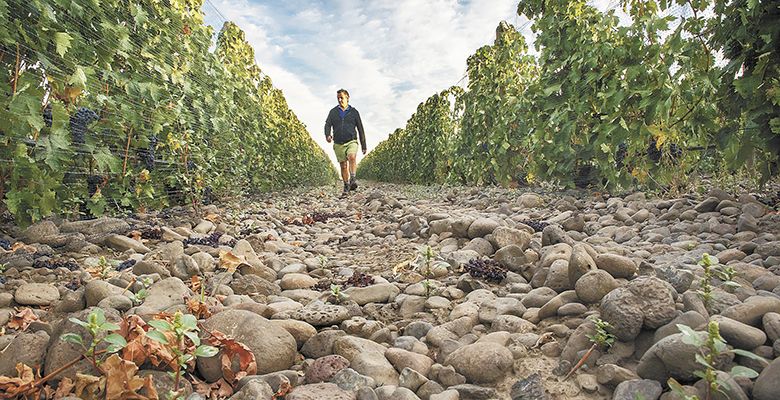Grapes Know No Borders
But People Sure Do
Let me riddle you this: Which Washington wine is Oregon’s top-scoring wine of all time? You got that, right? Which Washington wine is Oregon’s top-scoring wine...
Here are some hints: It’s not a Pinot Noir. It’s not a grape variety widely associated with Oregon (though Oregon is the home of this variety in the Northwest), and it’s not even from a winery considered an Oregon winery. It was grown and made in Oregon, but “Oregon” isn’t on the label, though it could be — but won’t be, according to the winemaker.
Enough riddling. Deep-in-the-weeds Northwest wine geeks will recognize this wine as the Cayuse Vineyards 2008 Impulsivo Tempranillo. This wine was scored at a pitch-perfect 100 points in Robert M. Parker, Jr.’s The Wine Advocate, No. 196, August 2011. And, yes, it is a completely legit, purely Oregon wine that everyone, but everyone, thinks of as a Washington wine.
Why this vinous trivia is important is that the wine comes from Oregon’s newest American Viticultural Area (AVA), The Rocks District of Milton-Freewater. Despite its unwieldy official name (which is inevitably shorthanded as “The Rocks”), this new Oregon AVA is a textbook example of what an AVA should be — as well as a case study in the often tortured emotions surrounding AVA cachet.
According to their regulatory authority, the Alcohol and Tobacco Tax and Trade Bureau of the U.S. Department of the Treasury — talk about unwieldy names — or TTB, the purpose of an AVA is to “…allow vintners and consumers to attribute a given quality, reputation or other characteristic of a wine made from grapes grown in an area to its geographic origin.”
The basic idea of an AVA, then, is to define as precisely as possible the distinctive viticultural characteristics (soils, climate, aspect, elevation, etc.) of a “delimited grape growing region” so consumers have an idea of what to expect from the wines. The Rocks AVA does this in spades, so to speak.
What makes The Rocks viticulturally distinctive is that the ground here is composed of oodles and oodles of ancient river-washed softball-sized cobblestones, unlike anything found elsewhere in the Northwest.
These ancient riverbed remnants were famously discovered for their winegrowing potential by Christophe Baron, whose Cayuse Vineyards wines are cult classics. This special “soil” offers many grapegrowing advantages not found in adjacent areas, from allowing vine roots to grow unusually deeply, to retaining daytime heat at night, to holding almost no water, to inhibiting erosion. This is precisely the kind of parameters the AVA system was designed to designate.
What makes The Rocks distinctive from a wine marketing standpoint is the inconvenient truth that this Oregon AVA is the source for many of the most prestigious and in-demand wines from Washington wineries. What happens when some of Washington’s best wines suddenly come from Oregon?
And what happens when Oregon’s top scoring wines aren’t cool-climate Pinot Noirs from the Willamette Valley, but instead warm-climate varieties from The Rocks — which is a child-AVA of Walla Walla Valley, itself a child-AVA of the Columbia Valley.
The world will turn upside down!
Some of the emotions — including my own — surrounding this border question can be seen in comments from Dr. Kevin R. Pogue of Whitman College in Walla Walla, who submitted the AVA petition to the TTB, as quoted by W. Blake Gray in his award-winning blog “The Gray Report” (blog.wblakegray.com). “The Oregon Wine Board,” Pogue told Gray, “has found it very convenient to ignore the wines of Walla Walla Valley.” With the establishment of The Rocks AVA, he continues, “They can’t ignore it anymore.”
Of course, this simply isn’t the case. In a series of educational presentations on Oregon wine that the Oregon Wine Board commissioned me to deliver throughout the Northwest, four of my slides contained references to the Walla Walla Valley AVA (including maps) as part of Oregon, and one slide specifically covered the then-pending Rocks AVA — including explicit statements about the high-scoring, non-Pinot wines from that region, as well as the cross-border labeling issues that The Rocks AVA creates.
Oregon ignores Walla Walla Valley? Hardly. Maybe the shoe is on the other foot.
Andy Perdue at GreatNorthwestWines.com reports that Baron won’t be using The Rocks AVA on his wines from there. He wants to stay stolidly Washington, it seems. The Oregon wine presentations I delivered were scheduled to be given in Washington but had to be canceled for lack of interest; folks in the state apparently didn’t much care about Oregon — even if it was the home of their high repute “Washington” wines.
Whatever.
Winegrapes know no borders, only people do. Winegrapes pay attention only to climate and soil, not Oregon and Washington — they grow best where the conditions are best for them to grow. If those conditions happen to be on the Oregon side of the Walla Walla Valley AVA, then why wouldn’t Oregon be proud to claim these wines as its own, even if they aren’t Pinot Noir? It just bolsters our claim to vinous greatness.
After all, an AVA by any other name would still taste as sweet.


 Cole Danehower is a James Beard Award-winning wine writer and wine industry marketing consultant who has been reporting on the wines of Oregon and the Pacific Northwest since 1998.
Cole Danehower is a James Beard Award-winning wine writer and wine industry marketing consultant who has been reporting on the wines of Oregon and the Pacific Northwest since 1998.






